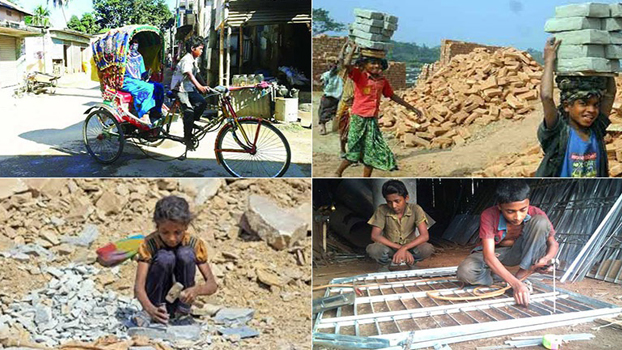Kids still in perilous jobs

Under-aged children working as labourers is a common phenomenon in Dhaka city. However, most of the jobs are too risky for the children to be involved in.
Scenes of children illegally doing odd jobs, dangling from buses or working in factories or on construction sites are not unusual. However, there seems to be no monitoring to shed light on the current condition.
An illegal activity such as child labour has been tagged as socially accepted. One of the contributing factors to this situation is the lack of concern over the issue.
Twelve- year old Abdul Mushfiq told this correspondent that he passed 5th grade in a municipal school but discontinued his studies last year. He now works as a helper in a fuchka stand in Dhanmondi.
“I was sitting at home for months and we were struggling a lot. I was not getting any output from school but I get money every day now and this is important for our daily life”, said the 12 -year old.
When contacted , Mushfiq’s father Abdullah Motin said that last year even the rickshaws were off for months. Eventually, it became a question of the family’s survival. His son earns TK 200 every day which is a significant amount for the family’s daily budget.
Fourteen- year old Joti, helper in a local bus in the capital told this correspondent that he has never gone to school. He started working at the age of 10 doing local odd jobs and worked as a helper in a leguna before joining the bus as a helper. He has no interest in going to school because he is already earning and that is his priority.
In a detailed discussion with the Bangladesh Post, Bangladesh Shishu Adhikar Forum (BSAF) Director, Abdus Shahid Mahmood shared that poverty can be identified as the main reason behind more children getting dragged into risky jobs, especially during the pandemic.
He told the correspondent that most of the children who work are involved in risky jobs that are not in the country’s list of jobs recognized as risky. Jobs such as domestic help or helpers in public transports are highly risky.
“Several domestic helps around the age of 12 are ill-treated, beaten and sometimes even killed. However, there is no accountability at times. Children hang from legunas all over the country in front of all the public and authorities but no one bats an eye”, he added.
He added that children are put into work to financially contribute to the family. Even if the government provides free schooling and books, many parents are not aware of it or prefer the immediate money the child is earning”, said the director.
In a report, Tuomo Poutiainen, Country Director, ILO Bangladesh said, “Up until the current crises hit, Bangladesh had been making great strides in reducing child labour”.
Tomoo Hozumi, UNICEF Representative in Bangladesh said, “The COVID-19 pandemic has a particularly negative impact on the lives, hopes and future of the most vulnerable children. Closure of schools and reduction of family income expose many children to the risk of child labour and commercial sexual exploitation.”
He said studies have shown that the longer children are out of school, the less likely they are to return. We need to prioritize education and the protection of children now and throughout the duration of the pandemic.
Kabir Uddin Ahmed, director of Industry & Labour Wing of the Bangladesh Bureau of Statistics told Bangladesh Post that a survey is underway in the current year. However, in this regard, the last survey was done in 2013.
Last year, it was observed in the ‘Dialogue on National Plan of Action (NPA) on Elimination of Child Labour’ that about 90% of the child workers are engaged in informal sector where workers remain out of registration and are appointed without due process. This sector is also remains out of government monitoring.
Speakers including advocate Salma Ali, Co-Chair, Child Rights Monitoring Committee and Member of National Child Labour Welfare Council, said that it is needed to bring the informal sector under government monitoring, because child workers continue to face exploitation and mental and physical health risks here. Over 12 lakh children are working in hazardous condition in this sector.
They called for turning children into skilled human resources after recovering them from risky works, and increasing the capacity of children in greater structure through protection with joint involvement of government and non-governmental sector.




